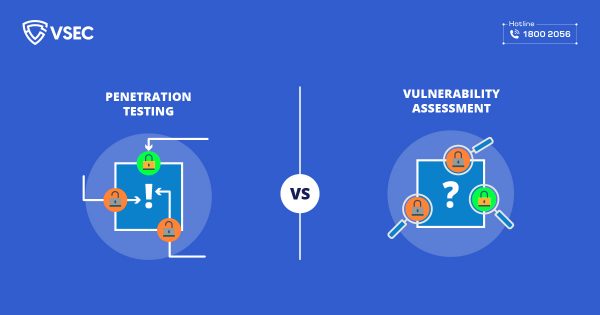
In the area of security, the terms Pentest and Red Team are often used interchangeably. So, what is the distinction between these two terms? We’ll discuss in this article to assist you learn more about which service would be the greatest fit for your organization.
Penetration Testing:

Pentester is someone who has hacker-like abilities and knowledge who approaches projects from a hacker’s perspective to undertake network, application, and device examinations. They look for ways to circumvent defensive measures and physical obstacles (bypassing) in order to find security flaws within targets or organizations. An skilled pentester can identify a target’s weak points while also building hacker scenarios for prospective attacks, methods of exploitation, and scope of impact, and then make recommendations for the best system handling and defense.
In this activity, Pentester employs automated testing tools to uncover a variety of cybersecurity issues, as well as manual testing to examine the organization’s attack vulnerabilities. Pentesting has become an essential requirement for most companies in assuring data safety in the light of an increasingly complicated cybersecurity ecosystem. Even firms that assume they do not have any valuable information to protect face hazards when hackers take control, install harmful software, disrupt services,… and cause substantial disruptions during operations.
Although many firms have IT teams that build, administer, and oversee daily security policies, it is nevertheless recommended that these units undergo pentesting to acquire a third-party view on the offensive aspects. Even if internal teams are doing well, this evaluation can help assess multidimensional defensive capabilities.
Red Team

Pentest’s goal is to find as many vulnerabilities and configuration flaws as possible, exploit them, and assess the level of risk. In contrast to Pentest, which seeks to identify all potential vulnerabilities, Red Team conducts targeted assaults using specialized tactics.
Red Team is often made up of a group of individuals who work together to thoroughly understand the amount of risk and the potential for real-world attacks across an organization’s technical, human, and physical aspects (assets, materials).
The Red Team employs a wide range of attack methods, including traditional deception, non-technical attacks (social engineering) on employees, and even impersonating a staff member in order to get administrator access. Red Team members are well-versed in the strategies, techniques, and processes that an attacker might employ in order to maximize the efficacy of their attacks.
Organizations with a strong presence in the information security business frequently use Red Team. After frequent pentesting and patching of most vulnerabilities, they demand individuals to undertake offensive assaults against the system’s security measures (bypass) in any feasible method, from numerous distinct angles.
Red team’s operations
The Red Team begins by doing reconnaissance in order to gather as much information as possible in order to comprehend the human factor, technology, and surroundings. This allows them to build and acquire appropriate tools for the attack. Red Team members can gather deeper insights into the infrastructure, physical assets, and employees by leveraging Open Source Intelligence Gathering, resulting in a better understanding of the target and its operations. This allows them to conduct more sophisticated attacks, such as writing malicious programs and configuring hardware trojans,…
Members of the Red Team will conduct a variety of attack actions, both technical and non-technical, in order to discover weaknesses in the target’s systems and processes. They then exploit these flaws to conduct attacks against servers, applications, networks, or to circumvent physical safeguards in preparation for escalation attacks.
Using Red Team provides organizations with a multifaceted view of their systems and processes, as well as the support of security experts to rectify, patch vulnerabilities, remedy issues, provide training, and address any necessary measures to ensure that those risks do not reoccur.


